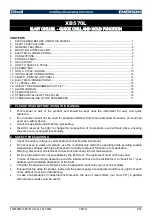
24
8 - REFRIgERANT lINE CONNECTIONS (30RWA)
(Split units for connection to air-cooled condensers)
8.1 - Recommendations for the installation of liquid
chillers with remote condensers
The 30RWA units (split units for connection to air-cooled
condensers) have been specially designed to optimise the
operation of split system installations, using air-cooled
condensers as the chiller heat rejection system.
The installation of an operational system is limited to the
connection of the air-cooled condenser inlet and outlet to
the 30RWA unit. The components such as the non-return
valve (in the discharge line), filter drier, moisture sight glass
and solenoid valves are installed and wired in the factory.
The Pro-Dialog Plus control system of the 30RWA units
incorporates the logic to permit control of the different fan
versions (single-circuit, dual-circuit, fixed and variable-speed
fan, separate ventilation or interlaced ventilation, i.e. common
ventilation for both refrigerant circuits).
To guarantee optimum and reliable performance of the
30RWA units (split units for connection to air-cooled
condensers) it is necessary to comply with the regulations
described below, when these units are connected to remote
condensers.
1. Size the discharge and liquid line piping according to
the recommendations in the following paragraphs (if
necessary, install a double riser to ensure correct oil
circulation in the refrigerant circuit).
2. Select a condenser with an integrated subcooler to
obtain a minimum of 3 K subcooling at the inlet to the
expansion device.
3. Connect the fan stages electrically to the accessory
control board, using the auxiliary board “AUX 1”,
analogue inputs and outputs and discrete remote
air-cooled condenser control outputs.
Refer to the paragraph on the description of the
ana-logue and discrete inputs and outputs for the
assign-ment of the fan stages.
4. Make the communication bus connection to the master
basic board of the 30RW unit.
5. In the Pro-Dialog Plus control configure the number of
fan stages and ventilation type in accordance with the
air-cooled condenser model used in the installation.
A fan speed controller may be required for the first
fan stage for operation at low ambient temperature
and part load.
ATTENTION: The air-cooled condenser must always be
used with a subcooler, normally with 8 K subcooling.
8.2 - general
Refrigerant pipe sizing must be carried out, taking account
of the following constraints:
Oil return to the compressor must be ensured for the
majo-rity of applications. Oil return is ensured by
entrainment. A minimum refrigerant velocity is required to
ensure entrain-ment. This velocity depends on the pipe
diameter, the refri-gerant and oil temperature (these are
treated as being the same in most cases). A reduction of
the pipe diameter per-mits an increase of the refrigerant
velocity. The problem of a minimum entrainment velocity
does not exist for the pipes that carry liquid refrigerant as
the oil is fully miscible here.
The pressure drop at the compressor discharge (pipes linking
the compressor outlet with the condenser inlet) must be
limited to avoid system performance losses (the compressor
power input inceases, and the cooling capacity decreases).
As a first estimate and for standard air conditioning
appli-cations, a 1 K pressure drop on the discharge side
decreases the cooling capacity 2% and increases the
compressor power input by 3%.
Increasing the pipe diameter permits limiting the pressure
drops.
The pressure drop in the liquid line (linking the condenser
outlet to the expansion device) must not result in a change
in phase.
The estimate of these pressure drops must include those
generated by the filter drier, moisture sight glass and the
solenoid valve, integrated into the 30RWA.
8.3 - Use of pipe sizing diagrams
In the annex to this document two pipe sizing diagrams are
shown. They allow an estimate of the cooling capacity,
corresponding to 1.5 K pressure drop for different pipe
diameters, based on the pipe length.
The following procedure can be used for pipe sizing:
1. Measure the length (in metres) of the piping under
consideration.
2. Add 40 to 50% to take account of special characte-
ristics.
3. Multiply this length by the appropriate correction
factor from Table 1 (this correction factor depends on
the saturated suction and discharge temperatures).
4. Read the pipe size from diagrams “Discharge piping”
and “Liquid line piping”.
5. Calculate the equivalent lengths for parts included in
the piping under consideration (such as valves, filters,
connections).
The equivalent lengths are normally available from
the component supplier. Add these lengths to the
length caculated in step 3.
6. Repeat steps 4 and 5 is necessary.
















































